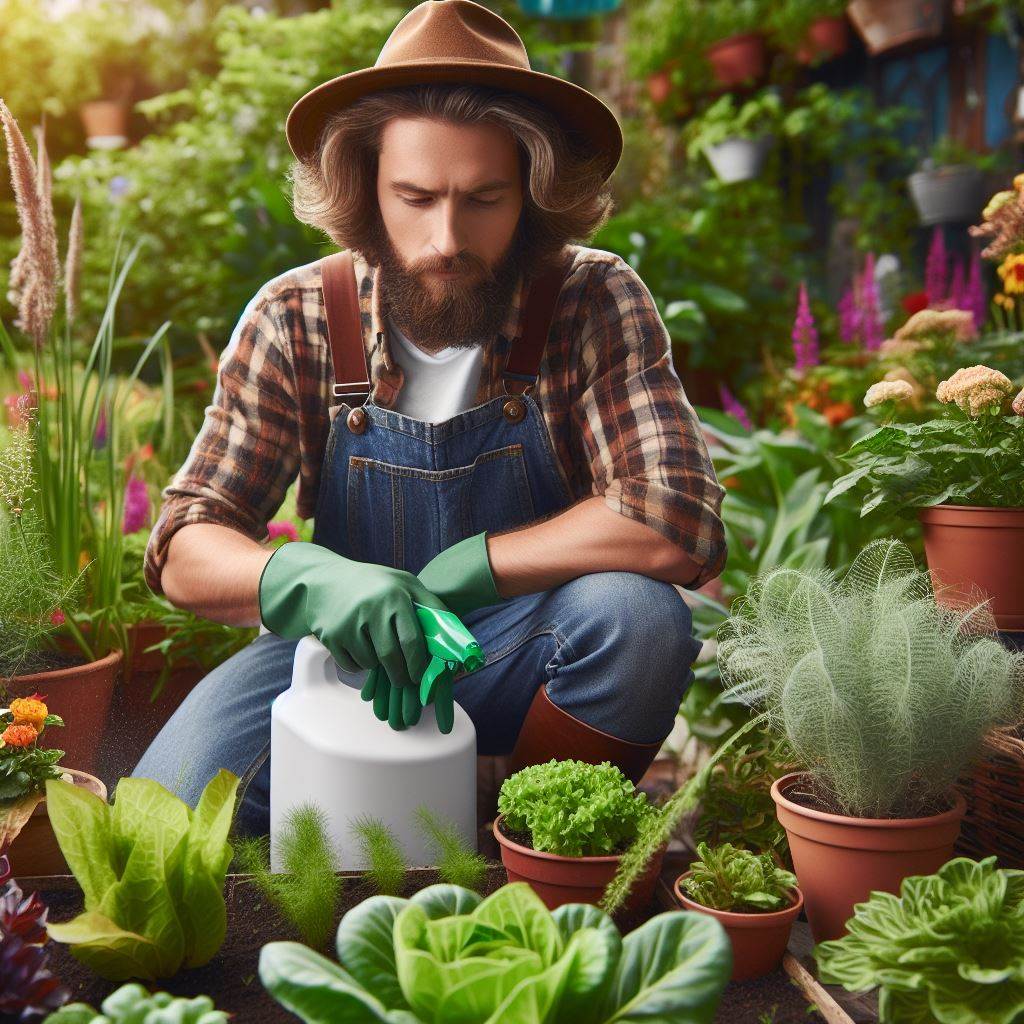Introduction
Spring is an exciting time for gardeners as it signals the start of a new growing season.
The importance of spring planting lies in the opportunity to cultivate a bountiful harvest.
To ensure successful spring planting, there are a few key tips to keep in mind.
Firstly, it is crucial to determine the appropriate time for planting specific crops.
Some plants thrive in cooler temperatures, while others prefer warmer weather.
Researching the ideal planting dates for each crop will maximize their growth potential.
Next, it is essential to prepare the soil properly before planting.
Loosening the soil and incorporating compost or organic matter will enhance its fertility.
Additionally, clearing any weeds or debris will prevent competition for nutrients and sunlight.
When planting, it is important to space the seeds or seedlings adequately to allow for proper growth.
Crowding can lead to stunted plants and increased susceptibility to diseases and pests.
Watering is another critical aspect of successful spring planting.
Monitoring the moisture levels and providing adequate hydration will promote healthy root development.
Lastly, regular maintenance such as weeding, fertilizing, and pruning is necessary to ensure plants thrive.
By following these tips, gardeners can enjoy a bountiful and beautiful garden in the spring.
The Right Time to Plant
When it comes to planting, timing is crucial. Planting at the right time ensures healthy growth and a bountiful harvest.
Here are some factors to consider when deciding when to start planting:
- Frost Dates: One of the most important factors to consider is the average last frost date in your area. Planting too early can lead to frost damage, while planting too late can result in stunted growth. Consult your local agricultural extension office for the frost dates specific to your region.
- Length of Growing Season: Another factor to consider is the length of your growing season. Different plants require different amounts of time to reach maturity. Make sure you have enough time for your plants to grow and produce before the first frost in the fall.
- Planting Zones: Planting zones are geographical regions determined by climate conditions. They help gardeners identify the best time to plant specific crops. The United States, for example, is divided into 11 planting zones. Know your planting zone to determine the ideal planting time for your area.
- Soil Temperature: Soil temperature plays a crucial role in seed germination and plant growth. Each plant has a specific temperature range at which it thrives. Use a soil thermometer to monitor the soil temperature and ensure it is within the favorable range for your desired crops.
- Other Weather Conditions: Besides soil temperature, other weather conditions can also impact planting. Excessive rain can lead to waterlogged soil, inhibiting root growth. High winds can damage young plants. Be aware of upcoming weather forecasts and plan your planting accordingly.
Different Planting Zones and Their Timelines
To better understand when to plant, let’s take a closer look at planting zones and their timelines:
- Zone 1 (Northern Alaska): With a very short growing season of less than 60 days, plant cold-tolerant crops like radishes and lettuce in late spring.
- Zone 3 (Northern Midwest and New England): The growing season ranges from 90 to 120 days. Start planting cool-season crops like peas and spinach in early spring and warm-season crops like tomatoes and peppers after the last frost.
- Zone 6 (Mid-Atlantic and Midwest): With a growing season of 150 to 180 days, you can start planting cool-season crops as early as March and warm-season crops in late April or early May.
- Zone 9 (Southern California and Florida): Enjoy a long growing season of up to 300 days. Plant cool-season crops in the fall and warm-season crops throughout the year.
The Importance of Soil Temperature and Other Weather Conditions
Soil temperature and other weather conditions greatly impact plant growth and development. Here’s why they are crucial:
- Seed Germination: Seeds require specific soil temperatures to germinate successfully. Planting too early when the soil is cold can result in poor germination rates and low plant vigor.
- Root Development: Adequate soil temperature enables robust root development. Cold soil retards root growth, hindering nutrient uptake and overall plant health.
- Disease Prevention: Weather conditions, such as excessive rainfall or high humidity, can create a favorable environment for plant diseases. Planting in favorable weather conditions reduces the risk of disease outbreaks.
- Nutrient Availability: Soil temperature affects microbial activity, which influences nutrient availability for plants. Proper soil temperature ensures that nutrients are released for plant uptake at the right pace.
Basically, the right time to plant depends on various factors.
Consider frost dates, growing season length, planting zones, soil temperature, and other weather conditions to ensure successful plant growth.
By planting at the optimal time, you’ll set the stage for a thriving and fruitful garden.
Choosing the Right Crops
When it comes to spring planting, selecting the right crops is essential for a successful harvest.
With so many options available, it can be overwhelming to decide what to grow.
However, by researching and considering a few key factors, you can make informed choices that will optimize your garden’s potential.
Researching and selecting appropriate crops for spring planting is the first crucial step.
Begin by identifying the vegetables, fruits, or herbs that flourish in your climate and growing zone.
This information can be easily obtained from gardening websites, local agricultural extension offices, or experienced gardeners in your area.
Understanding the specific requirements of each crop is equally important.
Some vegetables, like tomatoes, thrive in full sun, while others, like lettuce, prefer partial shade.
Research the ideal soil conditions, watering needs, and fertilizer requirements for each crop you’re considering.
This knowledge will ensure that you provide the optimal environment for their growth.
Considering local markets and personal preferences
Consider local markets and personal preferences when choosing spring crops.
Prioritize high-demand crops for selling and ones your family enjoys for personal consumption.
To simplify the selection process, here are some popular spring crops:
- Leafy greens: Lettuce, spinach, and kale thrive in cooler temperatures, adding nutrition to salads and smoothies.
- Root vegetables: Carrots, radishes, and beets do well in early spring, offering vitamins and tender, sweet flavors.
- Tomatoes: Choose disease-resistant varieties and provide sturdy support for these garden staples.
- Herbs: Basil, parsley, and cilantro add flavor to cooking, being easy to grow and harvest throughout the season.
Now, plan your spring planting by preparing weed-free, well-draining soil.
Enrich it with compost or organic matter for healthy plant growth.
Follow recommended planting guidelines for each crop, paying attention to spacing and preventing overcrowding.
Consistent watering and regular monitoring of plant progress are crucial.
Watch for signs of pests or diseases and take appropriate measures, like using organic pesticides or companion planting techniques, to protect your plants.
Throughout the growing season, maintain proper care.
Weed regularly, mulch to retain soil moisture and suppress weed growth, and provide support for taller plants.
Transform Your Agribusiness
Unlock your farm's potential with expert advice tailored to your needs. Get actionable steps that drive real results.
Get StartedIn short, diligent research and consideration of specific requirements lead to successful spring planting.
Select appropriate crops, understand their needs, and consider local markets and personal preferences for a bountiful garden.
Stay attentive to your plants’ needs, enjoy the satisfying rewards of your hard work, and happy gardening!
Preparing the Soil
As you embark on your spring planting journey, the key to success lies beneath the surface – in the soil.
Assessing soil quality is the first step toward a flourishing garden.
Begin by testing the pH levels using a simple kit. Knowing your soil’s acidity or alkalinity guides you in choosing the right plants.
Adjust the pH as needed by adding lime for acidic soil or sulfur for alkaline soil.
Next, evaluate the soil’s texture. Sandy soil drains quickly but lacks nutrients, while clayey soil retains moisture but can be dense.
Combining various soil types creates an ideal, loamy blend for most plants.
Tilling is a crucial technique to break up compacted soil and allow roots to penetrate easily.
Use a garden fork or tiller to turn the soil, ensuring aeration for optimal plant growth.
Composting is a sustainable practice that enhances soil fertility. Integrate organic matter like kitchen scraps, leaves, and grass clippings.
This natural fertilizer enriches the soil, providing essential nutrients for your plants.
Importance of proper drainage and weed control
Pay attention to drainage. Excess water can suffocate roots and foster diseases.
Improve drainage by incorporating organic matter and creating raised beds. This ensures water percolates through the soil, preventing waterlogging.
Weed control is paramount for a healthy garden. Weeds compete for nutrients and water, hampering your plants’ growth. M
ulching is a practical solution; it suppresses weeds, retains moisture, and improves soil structure.
Choose an organic mulch like straw or bark chips. Spread it around your plants, leaving space near the stems to prevent rot.
Mulching not only deters weeds but also regulates soil temperature, protecting roots from extreme conditions.
Proper spacing is vital. Avoid overcrowding to allow air circulation and minimize the risk of diseases.
Follow the recommended spacing for each plant type to maximize their growth potential.
Remember to rotate your crops annually. Crop rotation prevents soil-borne diseases and replenishes nutrient levels.
Plan your garden layout strategically, moving plants to new areas each season.
As you prepare the soil, keep in mind the importance of a well-balanced fertilizer.
Choose one with a balanced ratio of nitrogen, phosphorus, and potassium.
This ensures your plants receive the nutrients they need for robust growth.
In fact, investing time and effort in preparing your soil sets the stage for a successful gardening season.
Assessing soil quality, tilling, composting, ensuring proper drainage, and implementing weed control measures contribute to a healthy, thriving garden.
By actively engaging in these practices, you pave the way for a bountiful harvest and a garden that flourishes throughout the spring and beyond.
Read: Top 10 Plants for Beginner Urban Gardeners
Starting Seeds Indoors
Benefits of starting seeds indoors
- Extended growing season allows for earlier harvest of plants.
- Greater control over growing conditions, resulting in healthier plants.
- Cost-effective way to grow a wide variety of plants, including rare or heirloom varieties.
- Fun and educational activity for gardeners of all levels.
Necessary equipment and materials for seed starting
- Containers: Use clean and sterile seed trays, peat pots, or recycled containers.
- Soil mix: Prepare a well-draining potting mix with a combination of peat moss, vermiculite, and perlite.
- Seeds: Choose high-quality seeds from reputable sources to ensure good germination rates.
- Light source: Provide sufficient light using fluorescent lights, LED grow lights, or natural sunlight.
- Heat source: Maintain the ideal temperature for seed germination using a heating mat or warm location.
- Watering tools: Have a spray bottle or watering can to gently moisten the soil without disturbing the seeds.
- Labels: Use plant labels or popsicle sticks to keep track of the different varieties being grown.
Step-by-step guide for starting seeds indoors
- Choose the right seeds: Select seeds based on the specific requirements of your garden and the growing conditions in your area.
- Gather supplies: Collect all the necessary equipment and materials before getting started.
- Prepare containers: Fill the containers with the potting mix, leaving a small space at the top for watering.
- Plant the seeds: Follow the recommended depth and spacing for each type of seed.
- Water the seeds: Mist the soil gently to avoid displacing the seeds. Maintain moisture throughout the germination process.
- Provide proper lighting: Position the seeds near a light source or use artificial lights for 12-16 hours a day.
- Adjust temperature: Keep the seeds at the optimum temperature range for germination, usually between 65-75°F (18-24°C).
- Monitor growth: Regularly check for signs of germination and adjust watering and lighting as needed.
- Thin seedlings: Once the seedlings have developed their first true leaves, thin them out to allow proper growth space.
- Gradual hardening off: Slowly acclimate the seedlings to outdoor conditions before transplanting them into the garden.
- Transplant seedlings: When the seedlings are strong and the weather is suitable, transplant them into the garden.
- Care for seedlings: Provide regular water, nutrients, and protection from pests to ensure healthy growth.
By starting seeds indoors, you gain a head start on the growing season, increase your plant options, and foster a deeper connection with your garden.
With proper planning and care, your seeds will transform into thriving plants ready to be enjoyed in your garden.
Read: Small-Scale Farming: Maximizing Your Space

Direct Seeding
Direct seeding is a simple and effective way to plant crops directly in the garden without starting them indoors first.
It saves time and effort and can result in successful and healthy plants.
Here are some tips for direct seeding:
Crops that are suitable for direct seeding
Not all crops are suitable for direct seeding. Some crops, like tomatoes and peppers, require a longer growing season and are better started indoors.
However, there are many crops that can be directly seeded in the garden, such as lettuce, radishes, carrots, and beans.
Proper techniques for direct seeding in the garden
When direct seeding, it’s important to prepare your garden bed properly.
Start by clearing the area of any weeds or debris. Loosen the soil with a garden fork or tiller to create a loose, crumbly texture.
Rake the soil to create a smooth surface for planting.
Tips for proper spacing, depth, and watering
Spacing is important when direct seeding to allow plants to grow and develop properly.
Read the seed packet or plant label for specific spacing recommendations for each crop.
Generally, small seeds can be sown closer together, while larger seeds require more space.
Ensure that you sow the seeds at the proper depth.
Some seeds need to be lightly covered with soil, while others require planting at a specific depth.
The seed packet or plant label will provide instructions on how deep to sow the seeds.
Watering is crucial for successful direct seeding.
After planting, water the bed thoroughly to ensure that the seeds have enough moisture to germinate.
Once the seedlings emerge, monitor the moisture levels and water as needed.
It’s important not to overwater, as this can lead to rot or disease.
Direct seeding can be a rewarding and efficient way to start a garden.
By following these tips, you can ensure successful germination and healthy plant growth. Happy planting!
Read: Organic Farming: Basics for Small Plots
Showcase Your Farming Business
Publish your professional farming services profile on our blog for a one-time fee of $200 and reach a dedicated audience of farmers and agribusiness owners.
Publish Your ProfileManaging Pests and Diseases
Spring is a time of growth and renewal in the garden, but it can also bring its fair share of challenges.
Pests and diseases are two common problems that can affect spring crops.
However, with the right knowledge and techniques, you can effectively manage them and ensure a successful harvest.
In this section, we will explore some common pests and diseases that you may encounter in your spring garden, organic methods for pest and disease control, and monitoring and early detection techniques that can help you stay on top of any issues that may arise.
Common Pests and Diseases that Affect Spring Crops
- Aphids: These tiny insects can quickly multiply and damage young plant growth by sucking sap from leaves and stems.
- Cutworms: These are the larvae of certain moth species, and they cut through young plant stems, causing the plants to wilt and die.
- Powdery Mildew: This fungal disease appears as white powdery spots on leaves, stems, and fruits, and it can weaken and deform plants.
- Tomato Hornworms: These large green caterpillars can devour tomato and pepper plants, eating foliage and fruits.
Organic Methods for Pest and Disease Control
- Encourage beneficial insects: Plant a variety of flowers and herbs that attract beneficial insects, such as ladybugs and lacewings, which prey on pests.
- Use organic insecticides: Opt for organic insecticides made from natural ingredients like neem oil or insecticidal soap to control pests without harming beneficial insects.
- Crop rotation: Rotate your crops each year to prevent the buildup of pests and diseases in the soil.
- Practice good sanitation: Remove and destroy any infected plant material to prevent the spread of diseases.
Monitoring and Early Detection Techniques
- Regularly inspect your plants: Check your plants for any signs of pests or diseases, such as chewed leaves, wilting, or discoloration.
- Install sticky traps: Place sticky traps around your garden to catch flying pests like aphids or whiteflies before they can infest your plants.
- Handpick pests: If you spot any pests on your plants, remove them by hand and dispose of them away from your garden.
- Keep records: Keep a gardening journal where you note any pest or disease outbreaks, their location, and the measures you took to control them. This will help you identify patterns and make more informed decisions in the future.
By implementing these strategies, you can effectively manage pests and diseases in your spring garden while minimizing the use of harmful chemicals.
Remember that prevention is key, so regular monitoring and early detection are crucial.
With a little bit of effort and care, you can enjoy a bountiful and healthy spring harvest.
Happy gardening!
Read: Water Scarcity in Farming: A Growing Concern
Watering and Fertilizing
Establishing proper watering routines for different crops
- Determine the water needs of individual plants by considering their specific requirements and stage of growth.
- Monitor soil moisture regularly to ensure plants receive adequate hydration without overwatering.
- Adjust watering frequency according to weather conditions, such as rainfall or high temperatures.
- Use appropriate irrigation methods, such as drip irrigation or soaker hoses, to deliver water directly to plant roots.
- Water in the early morning to reduce evaporation and allow foliage to dry before evening, preventing disease.
- Provide deep, thorough watering rather than frequent shallow watering to encourage deeper root growth.
- Mulch around plants to retain moisture, prevent weed growth, and regulate soil temperature.
Tips for efficient water usage
- Collect rainwater in barrels or use a rainwater harvesting system to reduce reliance on municipal water sources.
- Group plants with similar water needs together to avoid over or under watering specific varieties.
- Consider using drought-tolerant plants that require less water and are more adapted to local conditions.
- Install a water-efficient irrigation system with timers and sensors to optimize water usage.
- Use water-saving techniques like drip irrigation or micro-sprinklers that deliver water directly to plant roots.
- Apply a layer of organic matter, such as compost or mulch, to improve soil water retention and reduce evaporation.
- Regularly check for leaks or malfunctioning in irrigation equipment to prevent wastage of water.
Understanding fertilizer requirements and application methods
- Test the soil to determine its nutrient composition and pH level, which helps identify fertilizer needs.
- Choose the right type of fertilizer based on the nutrient deficiencies identified in the soil test.
- Follow recommended application rates to avoid over-fertilizing, which can harm plants and pollute water sources.
- Apply fertilizers at the appropriate time, considering the specific needs of different crops and growth stages.
- Incorporate organic fertilizers, such as compost or manure, to improve soil structure and long-term fertility.
- Use slow-release fertilizers to provide a steady supply of nutrients to plants over an extended period.
- Avoid fertilizing during periods of heavy rain or when plants are drought-stressed to prevent nutrient leaching.
In review, establishing proper watering routines and understanding fertilizer requirements are crucial for successful spring planting.
By appropriately watering crops, using efficient water practices, and applying the right type and amount of fertilizer, gardeners can ensure healthier, more productive plants.
Remember to always consider the specific needs of different plants and regularly monitor their growth and condition to adjust watering and fertilizing practices accordingly.
Happy planting!
Mulching and Weed Control
Benefits of Mulching in Spring Planting
- Conserves Moisture: Mulching helps retain soil moisture, reducing the need for frequent watering.
- Suppresses Weeds: Mulch acts as a barrier, preventing weed growth and competition with your plants.
- Regulates Soil Temperature: Mulch insulates the soil, keeping it cooler during hot days and warmer at night.
- Prevents Soil Erosion: Mulch helps hold the soil in place, preventing erosion caused by heavy rain or wind.
Different Types of Mulch and Their Uses
- Organic Mulch: Made from natural materials like bark, straw, leaves, or grass clippings. It enriches the soil as it decomposes and provides insulation.
- Inorganic Mulch: Includes materials such as gravel, stone, or landscape fabric. It doesn’t break down but helps suppress weeds and conserve moisture.
- Biodegradable Mulch: This type of mulch is made of cornstarch or other bio-based materials that break down over time, enriching the soil.
- Colored Mulch: These mulches are dyed to give a decorative appearance to your garden while still providing the benefits of regular mulch.
Techniques for Weed Control without Harming Crops
- Hand Pulling: Regularly inspect your garden for weeds and manually remove them, ensuring you pull out the entire root.
- Mulch Thickness: Apply a layer of mulch about 2-4 inches thick to smother weeds and prevent their growth.
- Herbicides: Use herbicides sparingly and only as a last resort. Opt for natural or organic herbicides that are safe for your crops.
- Cultivate the Soil: Regularly till or cultivate the soil to disrupt weed growth and prevent them from taking root.
- Companion Planting: Interplanting certain crops can naturally discourage weed growth by crowding them out or releasing allelopathic chemicals.
- Solarization: Cover your garden bed with clear plastic during hot summer months to heat the soil and kill weed seeds.
- Mulch Renewal: As mulch breaks down, top it up to maintain an effective weed barrier and moisture retention.
In essence, mulching and weed control are crucial aspects of successful spring planting.
Mulching offers numerous benefits such as conserving moisture, suppressing weeds, regulating soil temperature, and preventing erosion.
Different types of mulch, including organic, inorganic, biodegradable, and colored, suit various gardening needs.
To control weeds without harming your crops, employ techniques like hand pulling, proper mulch thickness, careful herbicide use, and strategic cultivation.
Consider companion planting and solarization as additional weed control measures.
By implementing these practices, you’ll create a healthier and more productive garden in the spring planting season.
Conclusion
In this guide, we’ve unveiled key insights for a thriving spring garden.
Early March signals the start of planting. Choose veggies like peas and spinach. April is prime time for tomatoes and peppers.
May welcomes heat-loving crops, including cucumbers and squash. Embrace diversity in your garden for robust ecosystems.
Soil preparation is paramount—rich, well-draining soil fosters healthy growth. Timing is everything; heed each plant’s unique needs.
Utilize a planting calendar to stay on track. Don’t forget to water consistently and mulch to retain moisture.
Monitor for pests and diseases regularly. Foster pollinator-friendly habitats to enhance yield.
Remember, mistakes happen; learn and adapt. Gardening is a journey—celebrate every success, big or small.
Embrace the therapeutic benefits of nurturing plants. Now, armed with knowledge, embark on your spring planting adventure.
Your garden awaits transformation; let nature guide you. Happy planting!




